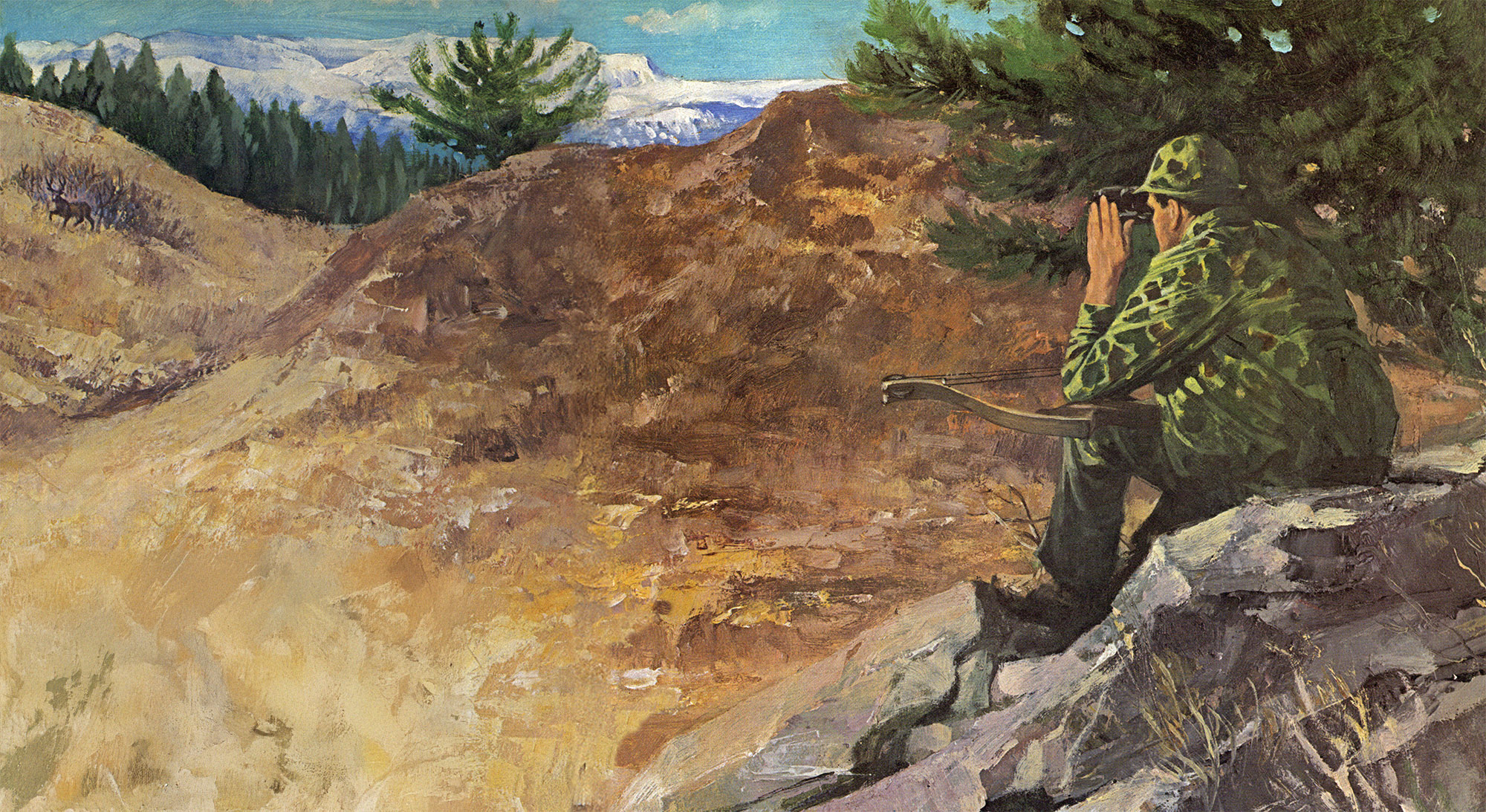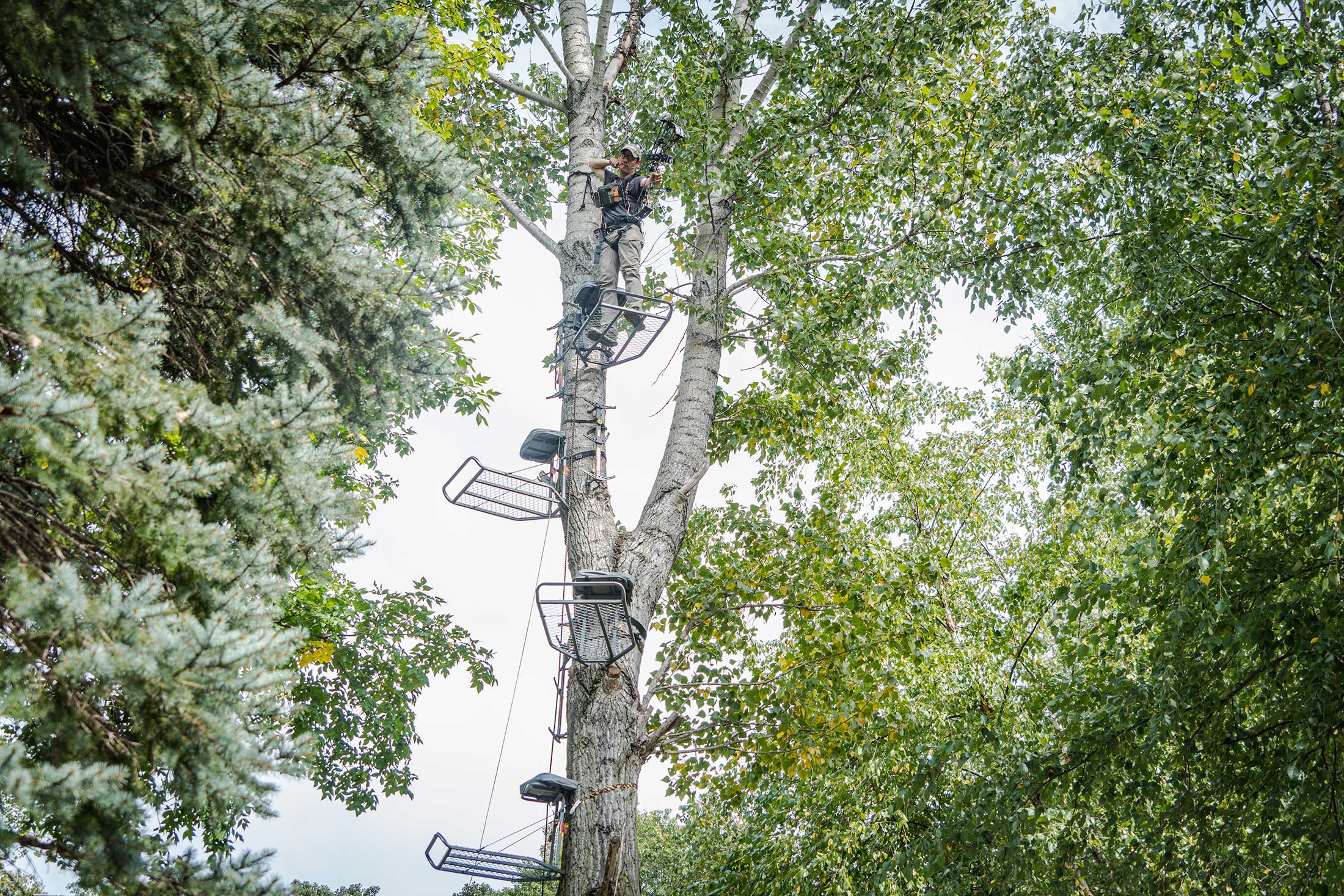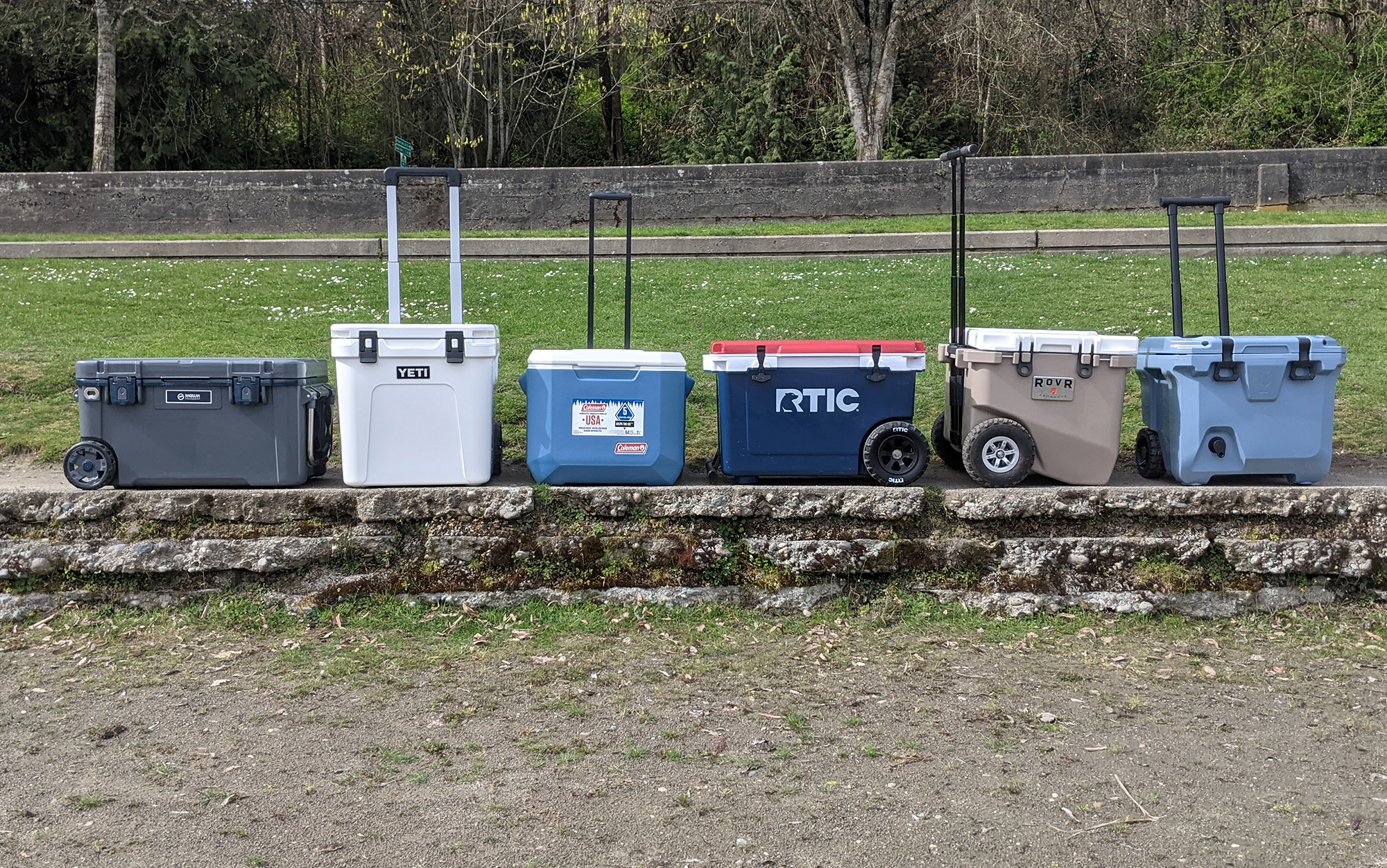A Dozen Blown Stalks: Teaching My Buddy to Bowhunt Mule Deer

Even a quarter-mile distant, the buck looked huge. His long body stood out black against golden aspens and, when he raised his head, the massive antlers glowed in the first sun of morning.
“Just look at him!” Don whispered, breaking the stillness.
I realized that I’d been holding my breath.
“That’s about as big as they come,” l said softly, as much to myself as to my friend.
It was the first morning of our Nevada bowhunt, and we watched the big buck through different eyes. For Don; this was only his second deer hunt, and his first bowhunt. He’d hunted once before with me and taken an exceptional buck with a rifle. But the hunt had been easy — perhaps too easy — and I wasn’t certain whether Don was really committed to the sport. I’d been hunting bucks for more than 25 years and, though Don and I were best friends since our high school days — and were partners in our upland and waterfowl hunting — he’d resisted my efforts to get him to hunt deer for years.
On that first trip, we had seen few deer and he’d killed the first buck that he had ever glassed. The hunt seemed over before it had really begun and, while during the off-season Don agreed to go again and waxed eloquent over the venison that he’d provided for his family, I didn’t sense the enthusiasm that he usually brought to his hunting.
In my two bow seasons, I’d seen many more bucks than during rifle hunts. And on each hunt, I had made stalks — taking hours to move in close. The experience of being close to deer, of watching them at length in an undisturbed state, had impressed me, a jaded deer hunter.
I gave a great deal of thought to that next hunt — there was a lot riding on it. Good hunting partners are hard to find, and I felt that, unless Don got the full flavor of deer hunting, he might not pursue it any further.
Instead of inviting him on another rifle hunt, I chose the bow. In my two bow seasons, I’d seen many more bucks than during rifle hunts. And on each hunt, I had made stalks — taking hours to move in close. The experience of being close to deer, of watching them at length in an undisturbed state, had impressed me, a jaded deer hunter. It had heightened my respect for the animal that I pursued and had made me more intensely aware of the age-old interaction between predator and prey.
On a bowhunt, I felt confident that Don would see and stalk game, and I hoped that the experience would win him over to the sport. But bowhunting is not easy, and his odds of killing a buck were not good. How would he react if he did not bring home a deer?
That thought flashed through my mind again as I lay in the sage, glassing that big buck.
“There are three more!” Don’s voice cut short my thinking. “Farther up the basin — 10 o’clock from the aspens.”
The bucks were there all right, and more besides. In the first hour’s light, we glassed nearly 20 in the mile-wide basin. Don was beside himself.
“Can’t we go after them?” he asked, his frustration all too clear.
“Not yet,” I explained. “They’re hard to stalk when they’re feeding on the move. We’ll let them bed in the aspens, then go in.”
As though on cue, the bucks began moving toward the shade of the trees and, in 15 minutes, they had vanished into the shadows. We cut back over the basin’s north rim, then headed up to get above the bedded bucks. On the way, I explained to Don how mule deer like to watch for danger from below, their noses scenting the upward-drifting thermals.
Read Next: The Best Compound Bows, Tested and Reviewed
All seemed fine as we dropped back into the basin and worked our way down the rocky, sage-covered slope. But Don, in his eagerness to get to the aspens, kept moving ahead, and l had to whisper him back. Finally, crouching in the sage, I repeated the advice that I’d given him before the hunt.
“These bucks have nothing to do but to try to hear, see, or smell you,” I explained. “You have to move slowly. When you think you’re moving slow enough, cut that in half. And remember: Spend three times as long looking as you do moving.”
The advice was sound, but my thinking wasn’t. By having unrealistic expectations of Don, I was settling the stage for problems. I failed to understand that it would be virtually impossible for him — never having stalked deer — to translate the words into reality. In hunting, you learn by doing — and usually by doing it wrong.
At the upper edge of a large aspen grove, we split up, Don taking the high route while I dropped down to work parallel, through the center.
“We’ll be only 50 or 60 yards apart,” I told him. “But the cover’s heavy and we may not see each other for a while. Don’t worry, just maintain your elevation.” A half-hour and 100 yards into the aspens, a movement ahead caught my eye. It was Don. He’d gotten 60 yards in front of me and was angling downhill, moving far too fast. I didn’t want to alert the bucks that I knew were bedded in the grove but, if I didn’t stop Don, he would ruin the stalk. My low whistle brought him up short, and I moved quietly to him. I was upset, but did my best to hide it.
In hunting, you learn by doing — and usually by doing it wrong.
“How did you end up down here?” I whispered. “You were supposed to stay up high.”
His eyes shone with excitement.
“Five minutes after we separated, I saw a buck in his bed,” he said. “He was maybe 35 yards away. I couldn’t believe it. Last time I got a buck right away and I figured I’d get this one, too. I had to kneel to get a clear shot but, when I tried to draw the bow, I couldn’t do it! I was shaking too hard!”
“Are you kidding?” I asked, looking at him hard. Don is strong and never had problems shooting in practice.
“Honest,” he said. “I told myself to settle down. I kept looking away and taking a breath, but I just kept shaking. Finally, the darn buck just got up and walked off. I didn’t know whether to laugh or cry, so I came down here.”
My anger had vanished as my friend told his story, but we still had a stalk to complete.
“Sometimes you’ll have to go around heavy brush but, if you go slow enough, you can get through most of it. You’re still moving too fast-you got way ahead of me-and we have to stay at separate elevations. Wait 10 minutes while I drop down another 50 yards, then we’ll go parallel again.”
Don nodded and I moved off, easing forward, testing each step for noise before shifting all my weight. I hoped Don was watching, and fell to wondering how to get him to slow down. I should have worried less about his technique and more about my own: I had gone less than 20 yards when two good bucks broke from their beds and crashed through low aspens down the slope. I was furious at my carelessness, and suddenly fell the gnawing feeling that the hum might be slipping away.
An hour later, I neared the west edge of the aspens, approaching low patches of thick brush that grew near the basin’s highest spring. The bucks liked such heavy brush for shade, and their well-camouflaged beds were extremely hard to approach.
I kneeled at the aspens’ edge, absorbing the stark beauty of the high country. enjoying the respite from the focused intensity or the stillhunt.
About 40 yards ahead, the brush cracked and a buck burst into view, running directly toward me. He thundered past, leaving me wondering what had jumped him. Don’s camouflaged form emerging from the brush ahead, provided the answer.
Now the hunt was over. Don having gotten ahead again and pushed out the brush patches. When I reached him, his face showed no awareness of what he had done.
“There are bucks everywhere!” he whispered. “I must have jumped half a dozen.”
“I know,” I said. “One almost ran over me … The day’s hunt had ended, I thought, and there was no point in trying to explain things now … We’ve covered this area. Let’s head for camp.”
That evening I did some hard thinking, and realized that the day’s problems had been caused by me, not by Don. First, I had not established my own priorities: Was my main purpose to take a buck or to have Don learn? I had assumed that both goals could be accomplished at once, and had picked the area’s best basin for the first day’s hunt. The result had been disastrous: The basin’s bucks had been badly disturbed and couldn’t be hunted again for two days. Since we were on a four-day hunt. that meant that we’d get only one more crack at them. And, while Don had seen deer and had been caught in the excitement of it, I was not at all sure that he had learned from his mistakes.
I decided that the next day’s hunt would be different. We would take daybreak. stands in another basin. hoping to catch the bucks moving down to their beds from the high feeding grounds. The change of pace, I thought, might be good after the heavy hiking of the first day. But when l explained the idea. Don was puzzled.
“How can we take stands below the bucks with upward thermals? And how do we get in position without spooking them?”
His questions showed that Don was beginning to think like a deer hunter. “The nighttime thermals run downhill and don’t normally shift until well after sunup,” I explained. “But getting to our stands won’t be easy. We’ll just have to be careful.”
The next morning’s hunt went well, with three does coming within 10 yards of my stand above an aspen-shaded spring. And. when I went to get Don from his stand. I was pleased to see that he’d selected a fine one. with brush to break his outline and a view of heavily used trails. I was also impressed that he’d seen a good buck at shooting range, but hadn’t taken the shot.
“He passed through those trees,” Don pointed. “He was only in the clear for a few seconds and, because he was moving, I didn’t shoot.”
“Smart decision,” I smiled. “You’re acting like an old pro.”
We stillhunted back toward camp, hunting parallel as we’d done the day before. But this time. I suggested that we stay within eyesight of each other so Don could get a better sense of pace.
“When you say ·slow,” he smiled as we emerged from the last grove, “you mean S-L-O-W!”
I had to laugh. “It’s funny how hard it is to learn. We spend all our lives learning how to do things faster, then try stalking deer. It’s a different world.”
Don winked, “Maybe that ought to tell us something about our world.”
Next dawn found us near the head-of a canyon, glassing the opposite slope. We had seell nothing in the first half-hour when Don nudged me.
He vanished in the aspens and I waited, expecting to see the buck burst into view. There was nothing but silence. The only movement was the heat waves, shimmering through my binoculars.
“Nice buck bedded below that dead pine,” he said, pointing.
Through my 8X glasses, I made out the velveted tips of good antlers. “Good spotting!” I told Don. “I would never have seen him. You spotted him; it’s your stalk.”
The stalk would not be easy. The buck’s location on the brushy sidehill would be tough for Don to pinpoint, and the combination of steepness and brush would make silent movement difficult.
Wee planned the stalk together. Don would swing around the canyon’s head and climb above the buck’s elevation. He would move along the slope until he was straight above the deer, then would move down.
But the stalk would take at least an hour, and the buck might move. I would stay on the opposite slope and watch him. We worked out a simple set of arm signals so thcl I could indicate whether the buck was feeding, moving, bedded, or alert, and so I could signal his distance and direction from the deer.
I watched Don go, bent low as he moved silently through flickering aspens, and felt for the first time that l was watching a hunter.
It was a great stalk. Just as Don crossed to the buck’s side of the canyon, the deer stood up and began feeding. The deer maintained bis elevation, moving in Don’s direction. Don kept going and, for tense minutes. it looked as though they might meet before Don got his bearings.
When Don first stopped for signals, he was obviously surprised that the buck had moved and twice gave me the “repeat” sign. Realizing that the buck was closer than he’d thought, he cut his speed and climbed.
The buck, after feeding, headed into a heavy patch of brush and did not come out. I watched the patch for 10 minutes and assumed that the buck had bedded again. Don, 150 yards above the bed, prepared for the descent. He took a final swig from his canteen, then slipped it off with his fanny pack — nothing extra to scrape the brush. He checked his broadheads, practiced nocking and drawing one, then replaced the arrow in the bow quiver. Satisfied. he headed down.
I watched tensely as the distance closed — 100, 80, 60 yards. Don moved carefully, testing each foothold, sometimes having to backtrack around heavy brush or noisy shale. I glanced nervously across the narrowing distance between him and the buck’s patch, afraid that the deer might sneak out undetected.
He closed the gap — 40 yards, 35. Don used all his limbs now, bracing with his off hand for maximum balance. His movements were controlled, measured, and slow.
At 25 yards, he came to the last obstacle between him and the buck’s patch — along finger or low, dense aspens. If he could make it silently through those, he would emerge 15 yards from the deer’s bed, above and to one side.
He vanished in the aspens and I waited, expecting to see the buck burst into view. There was nothing but silence. The only movement was the heat waves, shimmering through my binoculars. And then there was Don, his crawling form breaking the lower edge of the aspens. Frozen, he probed the buck’s patch with his eyes. Then, with excruciating care, he removed an arrow from the quiver and slipped it on the string. I watched, knowing that he would draw and shoot. But he did not.
Agonizing minutes passed, and I realized that Don could not see the buck from his position. He would have to move.
He did, though it was hard to see. First, the outside leg extended down the slope six inches, tested, braced, and held. Now the other. Then the bracing arm. Frozen, he stared, searching for the hint of gray, the sheen of hair though the shield of leaves.
Twelve yards, and now he was straight across from the buck’s bed. Don craned his neck — working, straining to pierce the vegetation with his eyes.
Suddenly my stomach tightened: What if early in the stalk, while I watched Don, the buck had slipped away? Or if I’d mismarked the brush patch across the canyon?
As though reading my thoughts, Don slowly turned his head to stare in my direction.
No, the buck must be there. I gave him the hand signal, arm straight across — 10 yards. Don riveted his eyes on the brush, searching. Through the glasses, I saw the buck’s arching leap before the crack of snapping brush reached across the canyon. He burst down the slope, wide antlers radiant in the late-morning sun, and escaped in the canyon’s heavy aspens.
Read Next: The Best Recurve and Longbows, Tested and Reviewed
Again, silence. I glanced back to Don, standing now, staring along the path of flight, then turning slowly to look at the buck’s bed.
We met at the grassy head of the canyon, sitting in the sun as we ate chunks or sourdough bread and salami, washing it all down with spring water.
“He was magnificent,” Don said. “What a hunt!” Tomorrow we would make another stalk and, at 12 yards, I would shoot a buck in his bed. But that would be tomorrow. Today, a hunter had been born.
This story, “A Hunter Is Born,” appeared in the February 1985 issue of Outdoor Life.
Read the full article here







